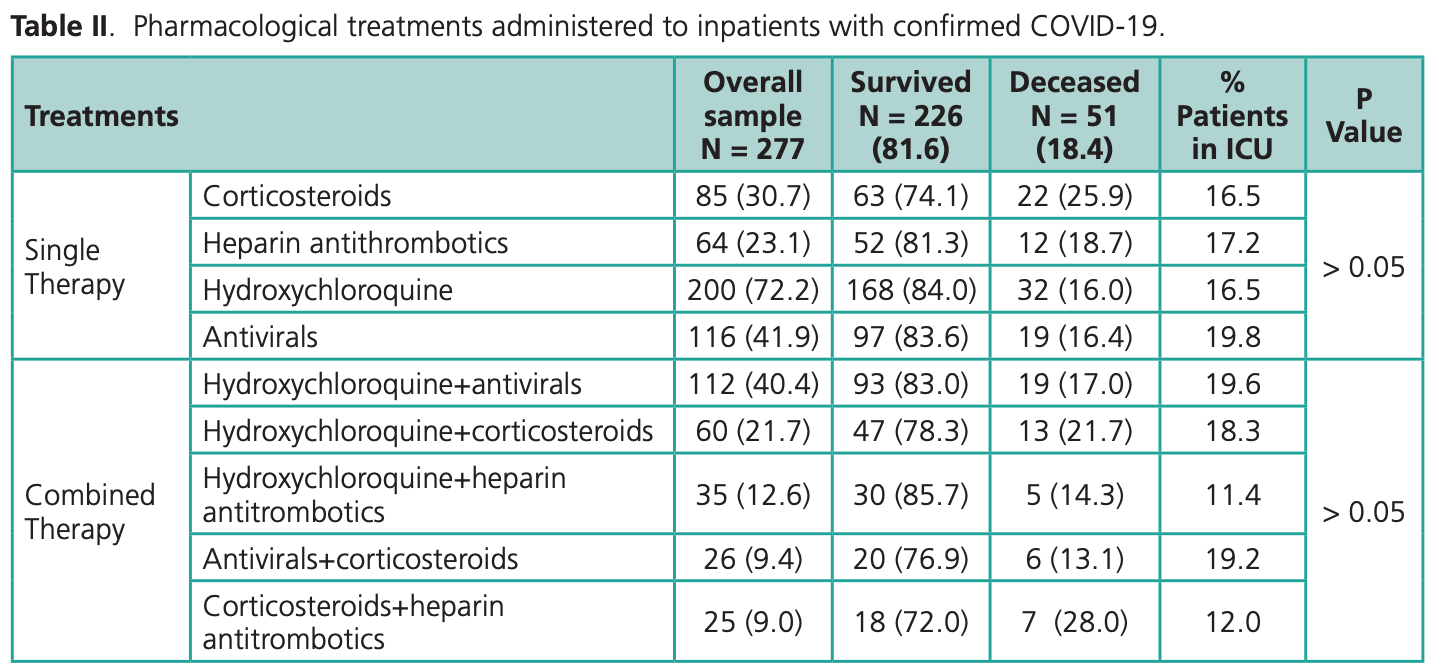A retrospective analysis on pharmacological approaches to COVID-19 patients in an Italian hub hospital during the early phase of the pandemic
G Menardi, L Infante, V Del Bono, L Fenoglio, D Collotta, P Macagno, C Bedogni, M Rebora, C Fruttero, M Collino
Pharmadvances, doi:10.36118/pharmadvances.2021.15
COVID-19 is a complex, multi-organ systemic disease caused by the SARS-CoV-2 coronavirus whose pathophysiological basis and pharmacological approaches are still to be defined. Our study aims to retrospectively evaluate the role played by clinical and demographic variables as well as the specific therapies administered in COVID-19 patients admitted to a referral Hospital in Northern Italy (Santa Croce e Carle Hospital, Cuneo) during the COVID-19 first epidemic wave. We analyzed data from 277 patients with virological diagnosis of COVID-19 who were admitted to the hospital from February 20 th to April 30 th 2020. The inpatients' pharmacological treatments and clinical outcomes were assessed up to May 31 st 2020. Correlations between pharmacological treatments as well as clinical and demographic variables and clinical outcomes have been performed. Several drugs were used in different dosages and combinations. In the first weeks of the epidemic, the most widely used drugs were hydroxychloroquine and the antivirals lopinavir/ritonavir and darunavir/cobicistat, then replaced by corticosteroids and heparin derivatives. Supplementation with vitamin C, D, or polyvitamins exerted a slight, but not significant, increase in survival rate, mainly in patients over 65 years old. Results showed that age and comorbidities significantly affected the survival as shown by the Charlson Comorbidity Index which was significantly higher in patients who died than in those who survived, thus confirming that victims of the disease were mostly debilitated and elderly people. The most influencing COVID-19 survival factors here recorded were age and comorbidities. No statistically significant differences were detected among the different pharmacological treatments used in our clinical setting during the first epidemic wave.
Impact statement No significant differences have been recorded in terms of efficacy among the several pharmacological approaches used during the first epidemic way in an Italian hub hospital.
CONFLICT OF INTERESTS The authors declare that they have no confl ict of interests.
References
Annweiler, Corvaisier, Gautier, Vitamin D Supplementation Associated to Better Survival in Hospitalized Frail Elderly COVID-19 Patients: The GERIA-COVID Quasi-Experimental Study, Nutrients
Balasco, 'alessandro, Ferrara, Smaldone, Vitagliano, Analysis of the time evolution of COVID-19 lethality during the fi rst epidemic wave in Italy, Acta Biomed
Bertocchi, Foglietta, Collotta, The hidden role of NLRP3 inflammasome in obesity-related COVID-19 exacerbations: Lessons for drug repurposing, Br J Pharmacol
Boddu, Aurangabadkar, Kuchay, New onset diabetes, type 1 diabetes and COVID-19, Diabetes Metab Syndr
Bolzetta, Maselli, Formilan, Prophylactic or therapeutic doses of heparins for COVID-19 infection? A retrospective study, Aging Clin Exp Res
Cariou, Hadjadj, Wargny, Phenotypic characteristics and prognosis of inpatients with COVID-19 and diabetes: the CORONADO study, Diabetologia
Getachew, Tizabi, Vitamin D and COVID-19: Role of ACE2, age, gender, and ethnicity, J Med Virol
Holman, Knighton, Kar, Risk factors for COVID-19-related mortality in people with type 1 and type 2 diabetes in England: a population-based cohort study, Lancet Diabetes Endocrinol
Horby, Recovery, Group, Lim, Dexamethasone in Hospitalized Patients with Covid-19, N Engl J Med
Magliano, Harding, Cohen, Excess Risk of Dying From Infectious Causes in Those With Type 1 and Type 2 Diabetes, Diabetes Care
Mohamed, Gale, Kontopantelis, Sex Differences in Mortality Rates and Underlying Conditions for COVID-19 Deaths in England and Wales, Mayo Clin Proc
Nicoli, Solis-Soto, Paudel, Age-related decline of de novo T cell responsiveness as a cause of COVID-19 severity, Geroscience
Sanders, Monogue, Jodlowski, Cutrell, Pharmacologic Treatments for Coronavirus Disease 2019 (COVID-19): A Review, Jama
Schultze, Aschenbrenner, None, Cell
Scully, Haverfi Eld, Ursin, Tannenbaum, Klein, Considering how biological sex impacts immune responses and COVID-19 outcomes, Nat Rev Immunol
Singh, Ryan, Kredo, Chaplin, Fletcher, Chloroquine or hydroxychloroquine for prevention and treatment of COVID-19, Cochrane Database Syst Rev
Su, Kuo, Wang, Chang, Gender based differences in COVID-19, New Microbes New Infect
Williamson, Walker, Bhaskaran, Factors associated with COVID-19-related death using OpenSAFELY, Nature
DOI record:
{
"DOI": "10.36118/pharmadvances.2021.15",
"URL": "http://dx.doi.org/10.36118/pharmadvances.2021.15",
"author": [
{
"affiliation": [],
"family": "Menardi",
"given": "G.",
"sequence": "first"
},
{
"affiliation": [],
"family": "Infante",
"given": "L.",
"sequence": "additional"
},
{
"affiliation": [],
"family": "Del Bono",
"given": "V.",
"sequence": "additional"
},
{
"affiliation": [],
"family": "Fenoglio",
"given": "L.",
"sequence": "additional"
},
{
"affiliation": [],
"family": "Collotta",
"given": "D.",
"sequence": "additional"
},
{
"affiliation": [],
"family": "Macagno",
"given": "P.",
"sequence": "additional"
},
{
"affiliation": [],
"family": "Bedogni",
"given": "C.",
"sequence": "additional"
},
{
"affiliation": [],
"family": "Rebora",
"given": "M.",
"sequence": "additional"
},
{
"affiliation": [],
"family": "Fruttero",
"given": "C.",
"sequence": "additional"
},
{
"affiliation": [],
"family": "Collino",
"given": "M.",
"sequence": "additional"
}
],
"container-title": "Pharmadvances",
"container-title-short": "Pharm Adv",
"content-domain": {
"crossmark-restriction": false,
"domain": []
},
"created": {
"date-parts": [
[
2021,
9,
16
]
],
"date-time": "2021-09-16T14:02:02Z",
"timestamp": 1631800922000
},
"deposited": {
"date-parts": [
[
2021,
9,
30
]
],
"date-time": "2021-09-30T08:59:22Z",
"timestamp": 1632992362000
},
"indexed": {
"date-parts": [
[
2022,
4,
5
]
],
"date-time": "2022-04-05T16:16:44Z",
"timestamp": 1649175404273
},
"is-referenced-by-count": 0,
"issue": "3",
"issued": {
"date-parts": [
[
2021,
9
]
]
},
"journal-issue": {
"issue": "3",
"published-online": {
"date-parts": [
[
2021,
9
]
]
}
},
"member": "9508",
"original-title": [],
"page": "576",
"prefix": "10.36118",
"published": {
"date-parts": [
[
2021,
9
]
]
},
"published-online": {
"date-parts": [
[
2021,
9
]
]
},
"publisher": "Edra SpA",
"reference-count": 0,
"references-count": 0,
"relation": {},
"resource": {
"primary": {
"URL": "http://www.pharmadvances.com/a-retrospective-analysis-on-pharmacological-approaches-to-covid-19-patients-in-an-italian-hub-hospital-during-the-early-phase-of-the-pandemic/"
}
},
"score": 1,
"short-title": [],
"source": "Crossref",
"subtitle": [],
"title": "A retrospective analysis on pharmacological approaches to COVID-19 patients in an Italian hub hospital during the early phase of the pandemic",
"type": "journal-article",
"volume": "3"
}
